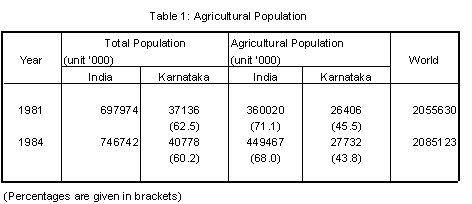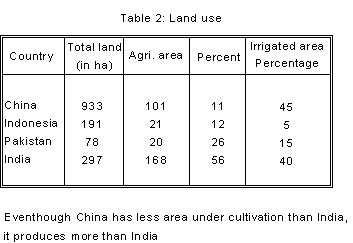|
Introduction
Agriculture is still a major activity in developing countries like India. Basic needs of human beings - food and energy - are met from agriculture. It forms a major part of the state domestic product. For example the share of agriculture in the State's domestic product was 37% in 1984-87.
Table 1 shows that the agricultural population was 62.5% for India and 71.1% for Karnataka in 1981. Agriculture accounted for only 45.5% of population in the world in 1981 and is decreasing at a slow rate. A reduction of 2 to 3% can be seen for India and Karnataka.

Agriculture needs several inputs - Water is considered an essential input. Initially, small tanks and canals were used for irrigation. New technologies in civil engineering brought in giant irrigation projects. Large dams impounded waters in rivers thereby creating large reservoirs. Canals from these dams are taken through long distances to fields in command areas. These reservoirs normally submerge large prime forest areas. Secondly, if the canals are not constructed properly, water leaks from the canals resulting in water logging of agricultural land near the dam. Salinity of soils is becoming a serious problem now.
Agricultural implements and fertilizer production need industrialization. Industries imply use of natural resources. Industries consume energy. Energy has to come from coal, firewood, oil or electricity. Again electricity may come from large hydro projects which destroy forest areas. Use of pesticides leads to pollution of different kinds - sickness amongst people, generation of new DDT resistant strains of mosquitoes and insects, etc.
Hence it is essential that ecologically friendly agricultural practices be developed, popularised and used extensively. Many agencies and individual farmers invent and use many such practices. Some examples are:
- use of biodegradable pesticide
- use of organic fertilizers
- efficient use of fertilizers increasing intake by the plant, reducing wastage and avoiding drainage of fertilizers
- multicrop farming
- growing of many species of trees - especially those which provide leaf manure, fix nitrogen in the soil and provide cattle feed and firewood - in the neighbourhood of farms. Sir M. Visvesvariah encouraged such practices in Mandya district.
- better water management practices like desilting tanks, lining of canals, use of drip irrigation, creation of small ponds and recharging ground water.
In this paper, we are looking at the food production activity in Karnataka. Particularly, from the point of view of water usage . The impact of large irrigation projects is also discussed. Table 2 compares India and some other countries in agricultural production.

|